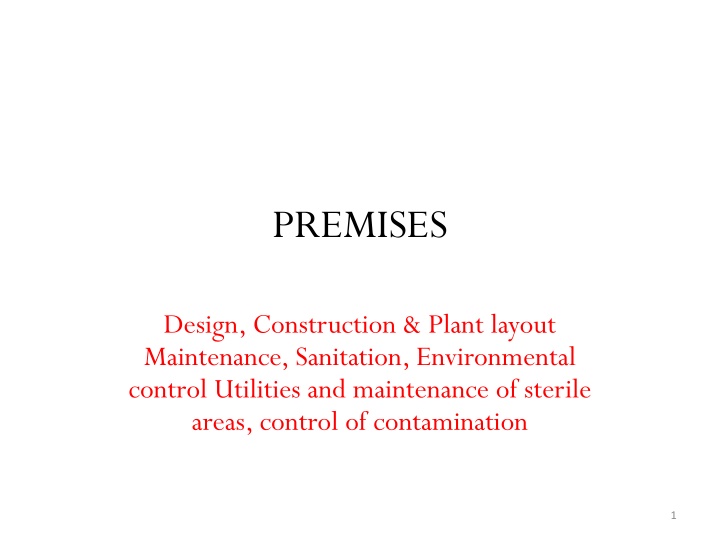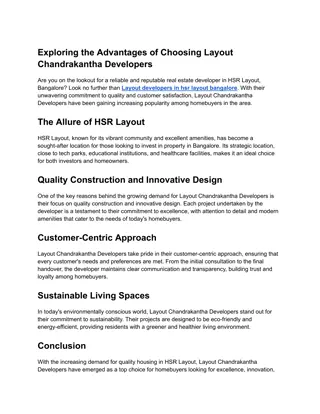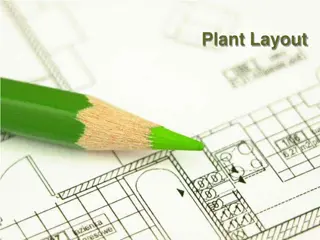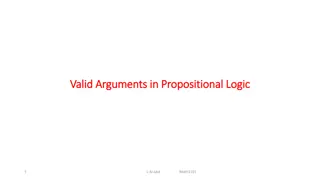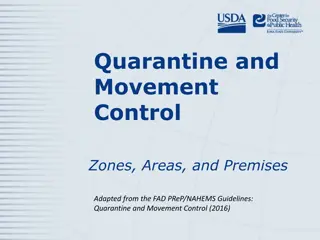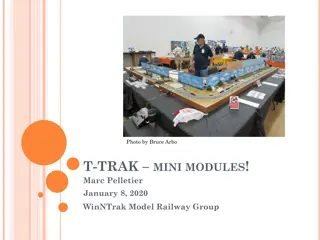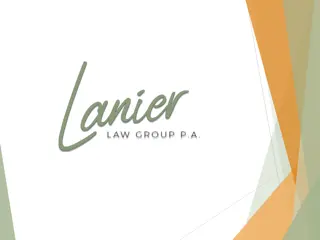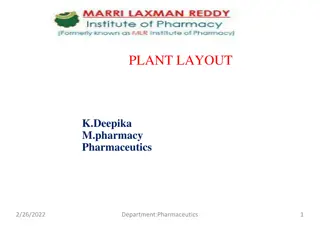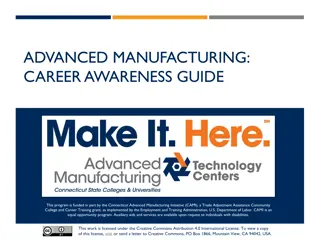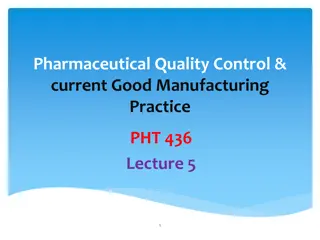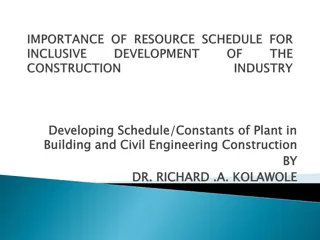Guidelines for Premises Design, Construction, and Plant Layout in Pharmaceutical Manufacturing
This comprehensive guide covers the key aspects of premises design, construction, and plant layout in pharmaceutical manufacturing. It delves into considerations such as location selection, environmental controls, utilities, maintenance of sterile areas, and contamination control. From site development plans to construction materials and validation procedures, it provides insights to ensure facilities meet regulatory standards and optimize operational efficiency.
Download Presentation

Please find below an Image/Link to download the presentation.
The content on the website is provided AS IS for your information and personal use only. It may not be sold, licensed, or shared on other websites without obtaining consent from the author.If you encounter any issues during the download, it is possible that the publisher has removed the file from their server.
You are allowed to download the files provided on this website for personal or commercial use, subject to the condition that they are used lawfully. All files are the property of their respective owners.
The content on the website is provided AS IS for your information and personal use only. It may not be sold, licensed, or shared on other websites without obtaining consent from the author.
E N D
Presentation Transcript
PREMISES Design, Construction & Plant layout Maintenance, Sanitation, Environmental control Utilities and maintenance of sterile areas, control of contamination 1
PREMISES: LOCATION Selection of location determines balancing of investment & profit. External & internal environment should be taken care of. Factors to be considered during purchasing, construction or alteration of existing facilities: 1. Availability of water, power, fuel, sewage & waste stream removal 2. Applicable laws 3. Proper space for future expansion 4. Accessibility of employees, materials, visitors 5. Environmental issues like water & air quality etc 2
LOCATION 6. Proximity of undesirable activities which can pollute or act as a source of microbial contamination 7. Availability of suitable labor force 8. Availability of proper security arrangements 9. Accessibility to interrelated operations of the company 10. Political situations like Govt. stability, trade policies, taxation, financial incentives etc. 3
DESIGN & CONSTRUCTION Premises used in Mfg. processing, packing, holding of drug product must be of suitable size, construction, location to minimize risk of errors & permit effective cleaning & maintenance in order to avoid cross contamination, build of dust, any adverse effect on the quality of products & shall conform to Factories Act 1948 Site development plan should address following : 1. Site resources & infrastructure like as green spaces, parking, road, rail access etc 2. Storm, water & waste management 3. Compliance with appropriate laws & regulations 4. Site security & access- fences, guard posts, cameras etc. 5. Buildings layout, usage, possible expansion 4
DESIGN & CONSTRUCTION 6. Utilities: Design, layout, electricity backups 7. Equipment- design, layout, spares, capacity 8. Pedestrian & vehicular traffic flow 9. Safety for personnel & equipments 10.External architecture to take into account the local environmental conditions 11.Ease of maintenance & cleaning 12.Selection & use of experienced contractors 13.Identification of project management responsibility 14.Validation plans & effective change control procedure 15.Construction materials 5
Guidelines for plant design & construction Walls: epoxy paint. 1. Position of walls- provide orderly movement of materials & personnel 2. Take into account the noise levels to provide acceptable working conditions 3. Should minimize cross contamination during storage, interdepartmental shipping 4. Walls in corridors, Mfg. & packaging areas- high concrete blocks, gypsum board with plaster finish. 5. Finish should be smooth & with enamel 6. In packaging areas- prefabricated partitions may be used for flexibility 6
Guidelines for plant design & construction Floors: Floor covering selected for durability, cleanability, resistant to chemicals. Floor- smooth, washable, no creak, crevices, no retention of dirt. Common floor coverings: Terrazzo: Hard wearing finish, tiles, poured in finish for Mfg. Tiles: effective sealing to prevent dirt, microbe retention Ceramic & vinyl sheeting: Not recommended for Production area Welded vinyl sheeting: provides even, easy to clean surface, for Production areas, for injectables as lack of joints improves cleaning & sanitation Epoxy flooring: Provides durable & readily cleanable and sanitation 7
Ceilings Suspended ceilings in office areas, laboratories, toilets and cafeterias In Mfg. area- seamless plaster or gypsum board having smooth finish Light fittings, air outlets and returns and sprinkler heads should be designed to assure ease of cleaning and to minimize potential for accumulation of dust SERVICES: Adequate provisions for drainage, water, steam, electricity, other services for easy maintenance of building Design of building should permit adequate space for proper placement of equipment & materials to prevent any mix ups & contamination. Adequate cleaning, washing & toilet facilities should be provided for the personnel 8
PLANT LAYOUT It is arrangement of physical facilities like machinery, equipment, furniture etc. to have quick flow of material at lowest cost with least amount of handling in processing the product from receipt of material to the shipment of finished product Arrangement of processing area, storage areas, handling area -efficient coordination Dimensions of work places, sequence of operations, flow pattern of materials, storage space for raw materials, in process inventory & finished goods, space for offices, path, toilets etc. 9
Importance of Plant Layout 1. Provide optimum relationship among output, floor area & Mfg. process 2. Easy production flow 3. Flexibility of operation 4. Make economic use of building 5. Promotes effective utilization of manpower 6. Employee s convenience 7. Safety 8. Comfort at work 9. Maximum exposure to natural light & ventilation 10
Factors influencing Plant Layout 1. New site development 2. Type of process & product control 3. Space available & space required 4. Operational convenience 5. Economic distribution of utilities & services 6. Health & safety considerations 7. Waste disposal problem 8. Possible future expansion 11
Types of Plant Layout 4 types of Mfg. unit plant layout Product or line layout All equipments, machines, other items required for processing are placed as per sequence of operations. All operations including production, testing, packaging etc. are carried out in one line One line of processing is dedicated to one type of product hence also called product layout One line should not cross other line Advantages: Low cost material handling, continuous flow of work, Lesser investment in inventory & work in progress Shorter processing time or quicker output Lower cost of Mfg/unit Disadvantages: High initial capital investment, Heavy overhead charges, Breakdown of one machine can stop whole production process Suitability 12
PROCESS LAYOUT Equipments, machinery etc. are not arranged as per sequence of operations. One kind of operation like granulation, coating, mixing etc for all the products is carried out at a particular work station or department. The distance b/w dept. must be short to avoid long distance movement of materials Should be convenient for inspection & supervision Advantages: Lower initial capital investment, effective supervision, breakdown of one machine does not result in complete work stop, Flexibility of expansion Disadvantages: Material handling cost are high due to back tracking, work in progress inventory is high, higher cost because more skilled labor required, Frequent inspection required results into costly supervision Need greater storage space 13
Fixed Position or location layout One complete product or a major part of the product is produced at one fixed location All facilities required are brought & arranged around that particular work centre/location Advantages: Saves time & cost Adjustments can be made Flexible layout Disadvantages: Heavy capital investment Very long production period Very large space required for storage of material & equipment Possibility of confusion & conflicts 14
Combined Layout Combines advantages of both product & process layout Sanitation Building must be maintained clean & sanitary condition, shall be free from infestation by rodents, birds, insects, other vermins, scraps, waste matter must be disposed timely Spilled materials like sugar, attracts creatures should be immediately cleaned Cleaning, sanitation programs should meet specific need of each facility Cleaning procedures should be written & validated properly Routine program shall indicate: specific areas to be followed, including equipment & materials to be used for cleaning Cleaning procedures to be followed, including equipment & materials to used for cleaning Personnel assigned to and responsible for the cleaning operation 15
Maintenance Poor maintenance impacts the product quality Any cracks, holes, in walls, floors, ceilings of warehouse provide entry to insects, birds, rodents etc Cracks etc cause problem in cleaning, sanitation results in cross contamination & microbial growth Floor cracks- safety hazard for people, dislodge materials from trucks during transfer Seepage of water from cracked roofs results in damage to materials, equipments, results in electric failures & fires Written procedures for suitable cleaning & sanitizing agents, fumigating agents, insecticides, rodenticides, insecticides, fungicides etc. Used in accordance to applicable laws. 16
Environment Control Variety of waste materials- pollute environment To reduce generation of these wastes to recycle, to increase product yield, reduce consumption of raw materials, fulfill the duties of hazardous waste management & Environment control Product/ its residues & waste never be allowed to escape into atmosphere/ or discharge in drainage Liquid effluents posing safety issues to be treated before discharge Written procedures, continuous monitoring of Temp., humidity inside Mfg. unit to be ensured Effective air extraction system with air filters to retain dust & protect factory & local environment 17
Environment Control Special environment conditions like pressure differentials- regularly monitored Mfg. area of oral solid dosage forms- double door entry airlock facility Entrance to topical product Mfg area suitable airlock 20 filters, air-conditioned, ventilation, fitted with exhaust system to remove vapors, fumes, smoke, dust. Temp., humidity in mfg area of metered dose inhalers depend on type of product & propellants handled in facility Between Mfg area and support areas difference of pressures of atleast 15 pascal is required 18
Environment Control Laminar air flow bench to provide adequate critical site environment HEPA filters unidirectional or columnar for aseptic compounding, free from airborne particulate contamination Verification of adequacy of sterile environment number of viable microbes & total no. of particles in controlled air environ. of area Air sampling of most prone to contamination location written plans to be followed Compounding personnel- trained, educated about environ monitoring process 19
Environment Control For controlling external Environment following are required: 1. Thermal Pollution control: requires off stream cooling system to handle thermal discharge from process. Wet cooling towers, dry cooling towers 2. Water Pollution control: By physical/ chemical / biological treatment 3. Air pollution control: By Removing particulate matter & gaseous pollutants from environment 20
UTILITIES & SERVICES Water: validated system for treatment of water to make it potable as per BIS or Pharmacopoeial specs. Use Purified water for all operations except for washing, cleaning Potable water must not contaminate materials/ equip Storage of water may be in tanks or vessels that don t affect quality of water & avoid microbiological load Periodic cleaning of tanks, records of cleaning Process water should at least meet the standards of drinking water as per WHO std. Written microbiological monitoring program for different types of water 21
UTILITIES & SERVICES Lighting Adequate natural or artificial lighting to facilitate cleaning, maintenance, proper operations To prevent photo degradation of products, light using Na vapor lamp to be provided with dispensing/ sampling booth for weighing/ sampling of highly sensitive materials Design & layout of factory usually make artificial lighting inevitable Installed such that does not create dust traps Position of light Selection of tubes or bulbs Intensity of light: min. req. is 500 lux 22
UTILITIES & SERVICES Glazed windows & sky lights used for lighting workstations should be kept clean Prevention of Glare from polished surface Prevention of formation of shadows to cause eye strain or risk of accident to any worker Gases Compressed air is commonly used N2 gas is used as inert gas for vials, ampoules, water for injection tanks Equipment used to generate store or distribute gas must be qualified Installation and operational qualification reports for equipments are approved then distribution system should be qualified to ensure delivery of gas 23
UTILITIES & SERVICES Steam Steam coming in direct contact with product, primary containers or other product contact surfaces should be sterile & pyrogen free. Steam can be of 03 types: Plant steam: Has boiler chemicals entrained Chemical free steam: without boiler additives Pure steam: when condensed meets USP grade purified water, produced by specially built steam generators Feed water used to generate pure steam should be purified water or water for injection or water from other sources of known chemical quantity 24
Maintenance of Sterile areas Manufacture of sterile products, parenteral preparations, sterile ophthalmic preparations as Sch M General Dampness, darkness and dirt to b avoided Supply of air, water, API, ingredients, maintenance of hygiene enviro as per prescribed Standards Building & civil works Proper Foundation of building Standardised building materials to be used Mfg areas- Support areas, preparation, change, aseptic areas 25
Maintenance of Sterile areas Aseptic areas must follow 1. Walls, floors, ceilings- impervious, non shedding, non flaking, non cracking 2. Walls flat- For proper cleaning 3. Ceiling to be solid & joints to be sealed 4. No sinks & drains in Grade A & Grade B areas 5. Doors- made of non shedding material like Al or steel & opened towards the higher pressure area so that they are closed automatically due to air pressure 6. Windows shall be made of similar material as the doors with double panel 7. Furniture- smooth, washable, SS etc 8. Air locked entrance to sterile areas, aseptic rooms 9. Installation of interlocking system, visual, audible warning systems to prevent opening of more than one door at a time 26
Air handing systems (Central air conditioning ) Provision of separate air handling systems for Critical areas like aseptic filling areas, sterilized component unloading areas & change rooms conforming to Grade B,C,D respectively. Grade In operation (a) Max. Number of permitted particles/cubic meter 0.5 m 5 m 3500 0 3,50,000 2000 35,00,000 20,000 Not defined Not defined At rest (b) 0.5 m 3.500 3500 3,50,000 3,50,000 5 m 0 0 2,000 20,000 A B (a) C (a) D (a) 27
Air handing systems (Central air conditioning) HEPA for A, B & C At rest condition: Grade A & B- corresponds to Class 100 or M 3.5 or Class 5 Grade C- corresponds to Class 10000 or 3.5 or ISO class 7 Grade D corresponds to class 100,000 or M 6.5 or ISO class 8 Requirement & limit for area shall depend on nature of the operation carried out 28
Grades & type of operations for aseptic preparations Grade A B C D Grades & type of operations for terminally sterilized Grade Types of operations A Filling of products, which are usually at risk C Placement of filling & sealing machines, preparation of solutions when usually at risk, filling of product when unusually at risk D Moulding, blowing operations of plastic containers, preparations of solutions & components for subsequent filling Types of operations Aseptic preparation & filling Background room conditions for activities requiring Grade A Preparation of solution to be filtered Handling of components after washing 29
Environmental Monitoring Written EM program must be laid down Environmental Parameters be verified & established at time of installation & thereafter monitored at periodic intervals. Following parameters with following frequencies need to be monitored: 1. Particulate monitoring in air: 6 monthly 2. HEPA filter integrity testing (smoking testing): Yearly 3. Air change rates: 6 monthly 4. Air pressure differentials: Daily 5. Temperature differentials: Daily 6. Microbiological monitoring: Daily 30
Limits for Microbiological monitoring of clean areas in operation GRADE Air sample Settle plates (dia: 90mm) Cfu/2hrs 1 5 50 100 Contact Plates (dia 55mm) Cfu/ plate 1 5 25 50 Glove Points 5 fingers Cfu per glove 1 5 -- -- Cfu/m2 1 10 100 500 A B C D 1. Values in the table are average values 2. Settle plates may be exposed for not less than 2 hrs in Grade B,C & D & not less than 30 minutes in Grade A area 3. If counts are above the limits in particulate & microbiological monitoring then appropriate action shall be taken immediately 31
GARMENTS Sterile area: non shedding, tight weave, single piece close fit , fastening at cuffs, neck, legs Hood to cover hairs No pleets, pockets, belts Each work session- cleaned, sterilised, protective garments Mask, gloves sterilized, no reuse Footwear- suitable plastic, rubber material, cleaned daily by bactericide Safety goggles to protect eyes, Written changing procedures Final changing room- full mirror to verify before entering sterile area Periodic inspection of garments 32
Sanitation Written procedures for sanitation of sterile processing facilities Specific trained workers for sanitation of aseptic areas Different sanitizing agents in rotation & concentrations as per recommendation Records of sanitizing agents should be kept Fresh distilled water to used for dilution of disinfectants in white change room Solutions labeled and documented HCHO/ any effective fumigant for aseptic areas fumigation Cleaning of sterile processing areas- air suction devices or non linting sponges/clothes to be used Air particulate quality in sterile mfg area to be evaluated regularly & records to be maintained 33
Equipments Unit sterilizers shall be double ended with inter locking between doors Effectiveness of sterilization- By biological inactivation studies using microbial spore indicators, then once a year by thermal mapping of chamber Sterilization by membrane filters- filter integrity tests before & after filtration For sterility of filling machines: simulation trials by sterile media fill should be conducted periodically SOP s & acceptance criteria for media fill- established, justified, documented SS/borosilicate glass for construction capable of washing/autoclaved SOP s of equipments for its calibration, operation & cleaning Calibration of equipments at suitable intervals with written programs with status documented and displayed 34
Water & Steam systems Potable water- 500 cfu/ml absence of E coli, salmonella, stahylococus aureus & P aeruginosa/100 ml sample used for preparation of purified water. Purified water prep. by de mineralization, meeting absence of non pathogenic microbes in 100 cfu/ml Hand washing in change room- use purified water Wash Containers, closures, machine parts- potable water followed by purified water Storage of purified water- SS, plastic tanks Water for injection- microbiological specs- not more than 10 cfu/100 ml, endotoxin level- not more than 0.25 EU/ml. (gram ve bacterial liposaccharides) Bulk solutions of liquid parenterals & disinfectants for aseptic areas made with WFI 35
Water & Steam systems Final rinse of product containers, machine parts- WFI Water for non injectable sterile products- eye drops- meet IP specs of purified water, Microb. Specs- not more than 10cfu/100ml & absence of pathogenic microbe P. aeruginosa & E coli in 100 ml Storage of WFI steam jacketed SS tanks having hydrophobic bacterial retention with 0.2 vent sterilized filters Lines for distribution of PW & DW- SS Written procedures for sanitation of water systems pumps, pipes, tanks etc Record of sanitation Written microbiological monitoring program for diff water used for sterile products Steam sterile, pathogen free- condensate Micro spec not more than 10 cfu/100 ml, Endotoxin level 0.25 EU/ml 36
Manufacturing Process Sterile products Mfg- areas of defined conditions Bio burden of bulk raw materials & bulk solution- periodic monitoring Bulk solution- microbial spec of not more than 10 cfu/ml Process of Mfg- time between start of preparation and sterilisation should be minimum Gases in contact with sterile product- filtered two 0.22 hydrophobic filters in series Washed containers- sterilised immediately before use Sterility of each batch should be confirmed 37
Form Fill seal technology or Blow Fill seal technology FFS units- automated machines- one continuous operation, containers are formed from thermo plastic granules, filled and then sealed FFS machines for terminal sterilization- Grade C Environ Filling zone within machine Grade A BFS tech- containers are moulded / blown in separate clean rooms, by non continuous operations Installed in Grade C Environ. 38
Terminally Sterilized Products Primary packaging materials- glass bottles, ampoules, rubber stoppers- prepared in Grade D If chances of microbial contamination Grade C Filling of products-termination sterilization Grade A with Grade C background 39
Membrane Filtration Sterile solutions by Membrane filtration in Grade C Aseptic filling of large volume parenterals, non fiber releasing, sterilised grade cartridge membrane filter with 0.22 Terminally sterilized products 0.45 porosity Immediately prior to filling, Second filtration with a separate 0.22 porosity sterilizing grade membrane filter shall be performed Integrity of sterilized filter should be verified & confirmed immediately after use 40
Sterilization by Autoclaving Validation of sterilization process at regular intervals, modifications maintained into records. Dry heat sterilization: (DHS) DHS cycle- time/ temp recording chart, with position of each temp probe determined at validation, compared with control temp probe After high temp phase during cooling, precautions required to avoid contamination of sterilized load Bacterial retaining filters at air inlet and outlets Use of Air circulation with positive pressure in chamber prevents entry of non sterile air Dry heat for removing pyrogens, then endotoxin test done for validation 41
MOIST HEAT STERILIZATION Reading of independent temp indicator should be checked in routine against chart recorder In vacuum phase of cycle, leak tests of chamber carried regularly All parts of load shall be in contact with sterilizing agent at required Temp & time Large volume parenterals shall be subjected to steam sterilization after filling & sealing only 42
Product containers & closures for sterile products Before sterilization of containers, rinsing with water for injection as per procedures Design should be so as to make them easy to clean, make seal airtight when fitted to bottles Examined after black or white background under diffused light to check for foreign particles 43
Completion of Sterilization Process All operations of Mfg. should be carried with shortest validated time Closing of containers must be as per validated methods Filled containers of parenteral products to be inspected individually Separate facilities for small and large volume Parenterals Records of results of tests of sterility, pyrogens, bacterial endotoxins, validation & simulation trials, Environmental Monitoring Temp, humidity etc, Servicing of HEPA, sterilizers & periodic maintenance of facilities & equipments 44
CONTROL OF CONATAMINATION It refers to all activities to control the existence, growth, proliferation of contamination in the premises It includes atmosphere, surfaces, particulate matter, microbes, contamination prevention and decontamination To ensure sufficient level of cleanliness May produce significant risk to production activities, personnels May lead to product damage, affect yield, product recalls etc detrimental to business 45
CONTROL OF CONATAMINATION How to prevent contamination? Clothings, HEPA filters Airlocks Clean room suits Nearly 80% of contamination enters thru entrances & exits Suitable floorings- attract, retain, inhibit microbe Copper alloy surfaces destroys microbes 46
CONTROL OF CONATAMINATION US EPA: listed antimicrobial copper products/ copper alloys: bedrails, handrails, over bed tables, sinks, faucets, door knobs, toilet hardware, computer keyboards, health club equipments, shopping cart handles etc. Measures to control contamination Prevent mixup & cross contamination, air handling systems, pressure differential, segregation, status of labelling & cleaning Proper SOP to be followed Processing of sensitive beta lactums in separate area Equipments labelling with status 47
Measures to control contamination Packaging lines- independent, previous packaging leftovers should be cleared first Before packaging: ensure that work area, packaging lines, printing machines, other equipments are clean, free from any products Line clearance check list, recorded Mfg environment maintained: Temp, humidity, cleanliness Authorized personnel to ensure change over into specific uniforms Segregated areas for recalled, rejected material 48
